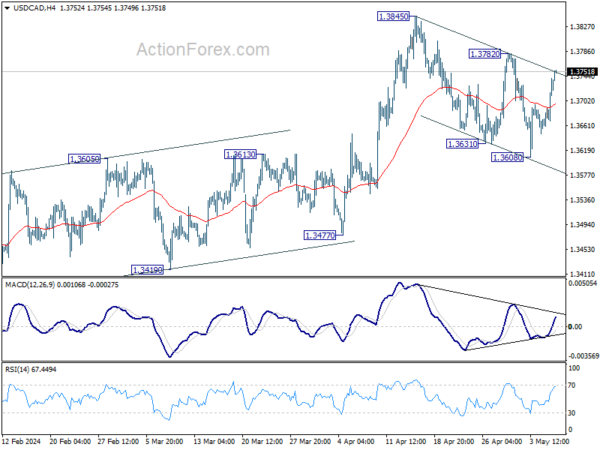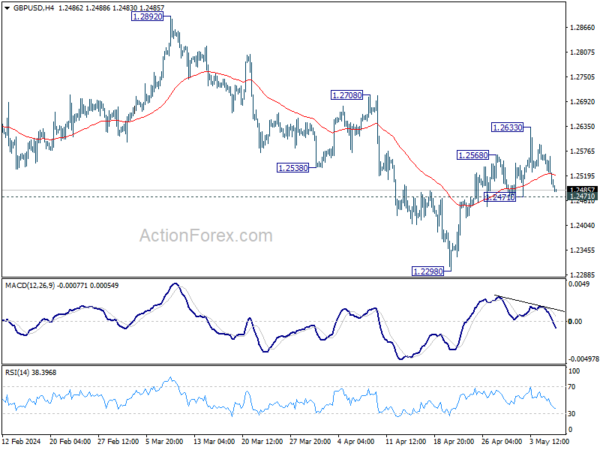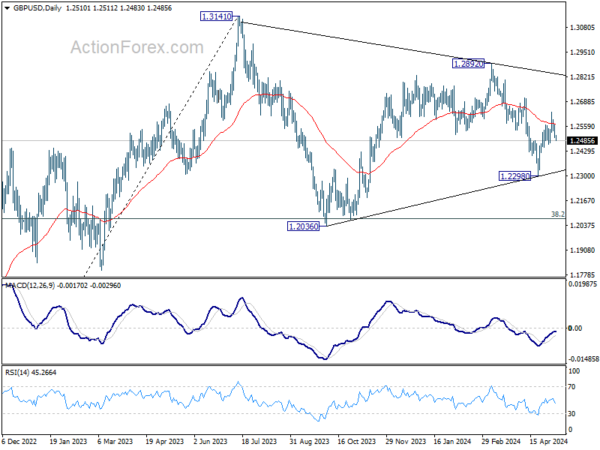Dollar Recovery Continues, But Bulls Struggle To Secure Full Control
Dollar’s rebound gained some momentum in Asian session today on resurgence of risk aversion. Selloff in Japan was most notable where key industry leaders like Fast Retailing, Nintendo, and Toyota saw substantial declines. The sentiment was further dampened after remarks from BoJ Governor Kazuo Ueda, who reiterated that Yen’s extended weakness might necessitate monetary policy responses.
Throughout the current week, Dollar is currently standing out as the best performer at this point. However, its ascent has been somewhat restrained, and capped below the previous week’s highs against other currencies. The greenback will have to demonstrate more strength to prove that it’s near term pullback started last week is over. Euro trails as the second strongest currency, followed by New Zealand dollar.
Conversely, Yen is the weakest performer, despite managing to retain a substantial portion of its gains from the previous week that were rumored to be bolstered by Japan’s strategic market interventions. Australian and Canadian dollars follow as the next weakest. British Pound and Swiss Franc are positioned in the middle. The Pound, in particular, stands at a critical juncture as market participants keenly await BoE’s forthcoming rate decisions and the release of new economic forecasts tomorrow.
Technically, USD/CAD’s breach of near term falling channel is strengthening the case that correction from 1.3845 has completed at 1.3608 already. Immediate focus is now on 1.3782 resistance. Decisive break there will argue that larger rally from 1.3176 is ready to resume through 1.3845 high. Based on current development in Dollar elsewhere, USD/CAD might not need to wait for Friday’s Canadian job data to make the move.
In Asia, at the time of writing, Nikkei is down -1.55%. Hong Kong HSI is down -0.52%. China Shanghai SSE is down -0.50%. Singapore Strait Times is down -1.04%. Japan 10-year JGB yield is up 0.0038 at 0.876. Overnight, DOW rose 0.08%. S&P 500 rose 0.13%. NASDAQ fell -0.10%. 10-year yield fell -0.0260 to 4.463.
Fed’s Kashkari: Interest rates likely to stay here for an extended period of time
Minneapolis Fed President Neel Kashkari highlighted at a conference overnight that the current interest rates are likely to be maintained “for an extended period of time” to ensure that inflation steadily returns to the target level.
Kashkari elaborated on circumstances that might prompt a shift in this policy. If inflation metrics “start to tick back down” or if there is a “marked weakening in the labor market,” Fed might consider lowering interest rates. Conversely, he warned that if inflation seems “embedded or entrenched now at 3%,” an increase in rates could be necessary to control inflationary pressures.
Further exploring the complexities of current economic conditions, Kashkari, in an essay, suggested that misjudgments regarding the tightness of existing policies might explain the “constellation of data we are observing.” He questioned whether the disinflationary trend is just slower than expected or if inflation is settling around 3%, indicating that “more work” might be required to meet Fed’s dual mandate objectives.
ECB’s Nagel warns of persistent inflationary pressures
Bundesbank President Joachim Nagel, a member of ECB Governing Council, cautioned about enduring inflationary challenges during a speech overnight. Nagel noted the confluence of factors, including supply chain resilience, impending labor shortages due to demographic shifts, and the green transition, all of which could exert upward pressure on prices.
“To improve resilience, some form of de-risking seems reasonable, especially in the case of strategically important goods,” Nagel said in a speech. “We should keep in mind that greater security for supply chains is likely to come with some additional price pressures.” These structural changes in the eurozone economy, Nagel argued, could sustain inflationary tendencies for an extended period.
Highlighting demographic trends, Nagel projected a significant annual decline of 80,000 individuals in the potential labor force starting from 2026. This demographic shift, he emphasized, could drive wage growth, thereby fueling inflationary pressures further.
Nagel reiterated the ECB’s commitment to price stability, emphasizing its mandate to curb inflationary pressures. “One thing is clear: Our mandate is price stability!” he said. “If there is more price pressure in the medium-term, we must take action against it… price stability is a prerequisite for an efficient adjustment process.”
BoJ Ueda signals shift in focus to exchange rate impacts
In comments made to the parliament today, BoJ Governor Kazuo Ueda underlined growing focus on the effects of currency movements rather than solely on wages, signaling a broadening perspective on economic influences.
Ueda pointed out that as recent behavior in wage- and price-setting has become “somewhat more active,” BoJ has to be “mindful of the risk that the impact of currency volatility on inflation is becoming bigger than in the past.”.
“Foreign exchange rates make a significant impact on the economy and inflation. Depending on those moves, a monetary policy response might be needed,” Ueda said.
Similarly, Finance Minister Suzuki expressed significant concern about the negative aspects of a weaker yen, particularly the pressure it places on import prices.
“Since Japan relies on overseas markets for food and energy, and a large portion of its transactions are denominated in dollars, a weaker yen could raise prices of imported goods,” Suzuki said.
Looking ahead
The economic calendar is light today. Germany industrial production, Italy retail sales, and US wholesale inventories final will be released.
GBP/USD Daily Outlook
Daily Pivots: (S1) 1.2481; (P) 1.2528; (R1) 1.2554; More…
Intraday bias in GBP/USD remains neutral for the moment and some more consolidations could be seen below 1.2633. Further rally is in favor with 1.2471 support intact. On the upside, above 1.2633 will resume the rebound from 1.2298 to 1.2708 resistance next. However, firm break of firm break of 1.2471 will indicate that this rebound has completed, and revive near term bearishness. Retest of 1.2298 should then be seen in this case.
In the bigger picture, price actions from 1.3141 medium term top are seen as a corrective pattern. Fall from 1.2892 is seen as the third leg which might have completed already. Break of 1.2892 resistance will argue that larger up trend from 1.0351(2022 low) is ready to resume through 1.3141. Meanwhile, break of 1.2298 support will extend the corrective pattern instead.
Economic Indicators Update
| GMT | Ccy | Events | Actual | Forecast | Previous | Revised |
|---|---|---|---|---|---|---|
| 06:00 | EUR | Germany Industrial Production M/M Mar | -0.4% | -1.10% | 2.10% | |
| 08:00 | EUR | Italy Retail Sales M/M Mar | 0.20% | 0.10% | ||
| 14:00 | USD | Wholesale Inventories Mar F | -0.40% | -0.40% | ||
| 14:30 | USD | Crude Oil Inventories | 7.3M |
The Penny Drops: Understanding The Complex World Of Small Stock Machinations
Micro-cap stocks, often overlooked by mainstream investors, have recently garnered significant attention due to rising c... Read more
Current Economic Indicators And Consumer Behavior
Consumer spending is a crucial driver of economic growth, accounting for a significant portion of the US GDP. Recently, ... Read more
Skepticism Surrounds Trump's Dollar Devaluation Proposal
Investors and analysts remain skeptical of former President Trump's dollar devaluation plan, citing tax cuts and tariffs... Read more
Financial Markets In Flux After Biden's Exit From Presidential Race
Re-evaluation of ‘Trump trades’ leads to market volatility and strategic shifts.The unexpected withdrawal of Joe Bid... Read more
British Pound Poised For Continued Gains As Wall Street Banks Increase Bets
The British pound is poised for continued gains, with Wall Street banks increasing their bets on sterling's strength. Th... Read more
China's PBoC Cuts Short-Term Rates To Stimulate Economy
In a move to support economic growth, the People's Bank of China (PBoC) has cut its main short-term policy rate for the ... Read more




